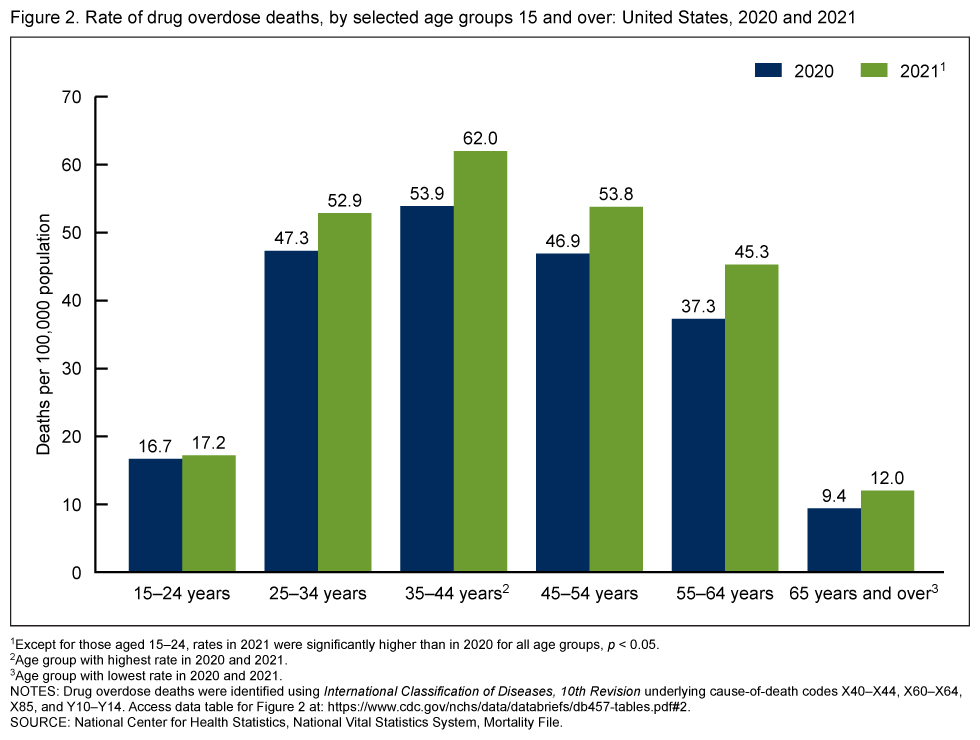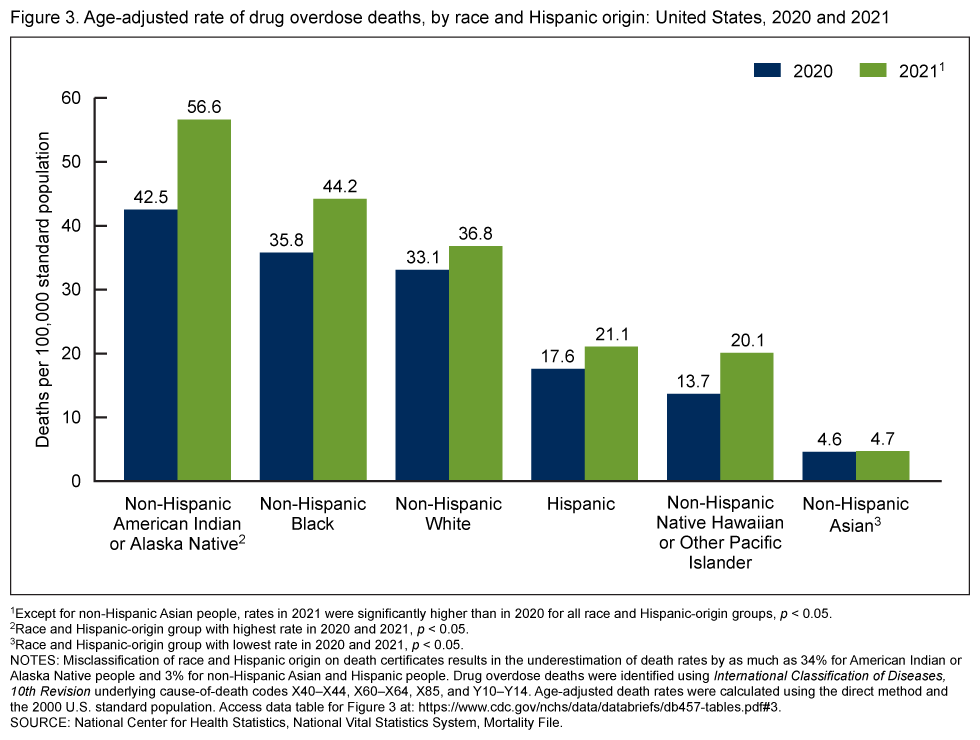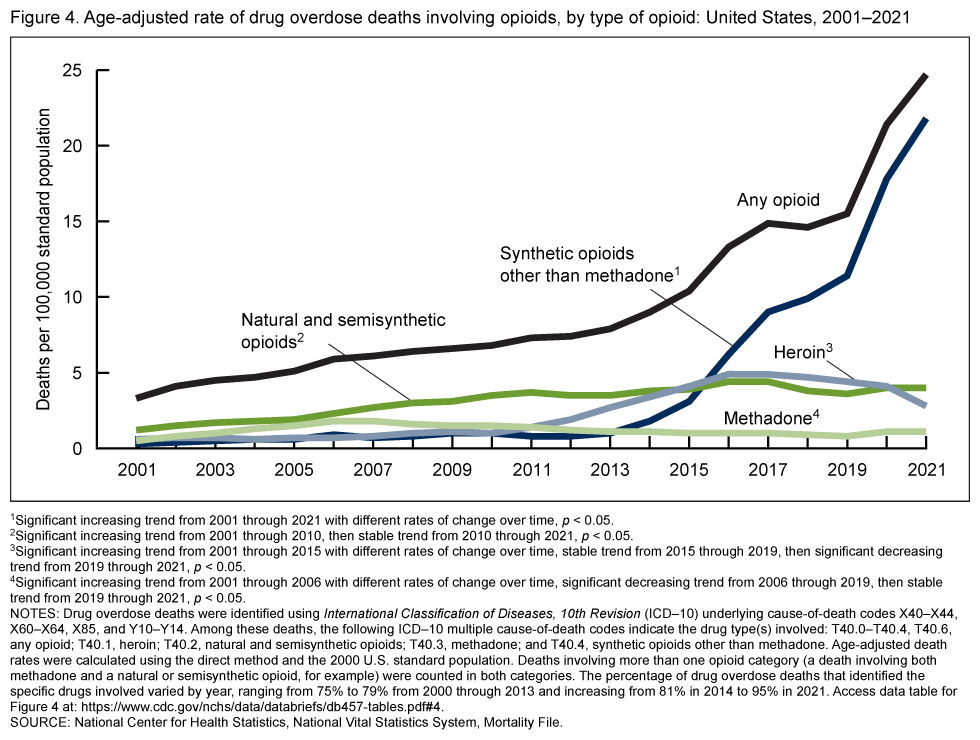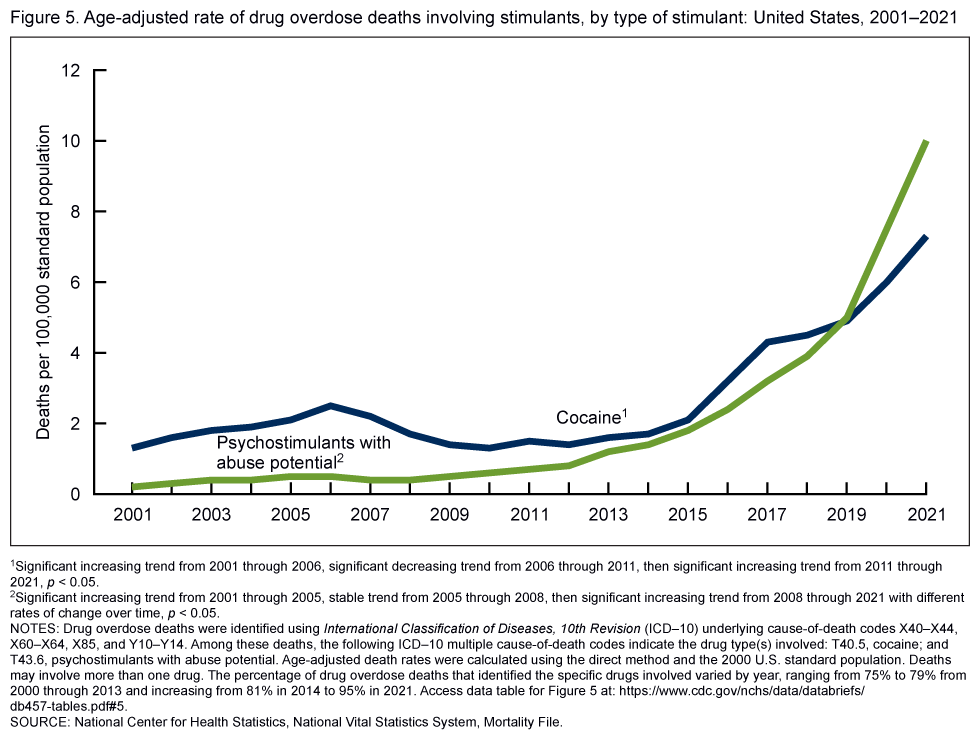Record 106,699 drug overdose deaths in the U.S. in 2021 – Overdose deaths have risen fivefold over the past 2 decades – Mortality rate now 32.4 per 100,000 people

By Merianne Rose Spencer, M.P.H., Arialdi M. Miniño, M.P.H., and Margaret Warner, Ph.D.
21 December 2022
(CDC) – Drug overdose deaths have been rising over the past 2 decades in the United States (1–4). This report uses the most recent data from the National Vital Statistics System (NVSS) to update statistics on deaths from drug overdose in the United States, showing rates by demographic groups and by the types of drugs involved (specifically, opioids and stimulants), with a focus on changes from 2020 through 2021.
Key findings
- In 2021, 106,699 drug overdose deaths occurred, resulting in an age-adjusted rate of 32.4 per 100,000 standard population in the United States.
- Adults aged 65 and over had the largest percentage increase in rates from 2020 through 2021.
- Drug overdose death rates increased for each race and Hispanic-origin group except non-Hispanic Asian people between 2020 and 2021.
- The rate of drug overdose deaths involving synthetic opioids other than methadone increased 22%, while the rate of deaths involving heroin declined 32% between 2020 and 2021.
- From 2020 through 2021, the rate of drug overdose deaths increased for deaths involving cocaine and those involving psychostimulants with abuse potential.
The age-adjusted rate of drug overdose deaths rose more than 14 percent from 2020 through 2021 in the United States.
- In 2021, 106,699 drug overdose deaths occurred, resulting in an age-adjusted rate of 32.4 per 100,000 standard population (Figure 1).
- Among the total population, the age-adjusted rate of drug overdose deaths increased from 6.8 in 2001 to 11.5 in 2006, was stable from 2006 through 2013, then increased from 13.8 in 2013 to 32.4 in 2021; from 2020 through 2021, the rate increased 14%, from 28.3 to 32.4.
- From 2020 through 2021, the age-adjusted rate of drug overdose deaths for males increased 14% from 39.5 to 45.1, and the rate for females increased 15% from 17.1 to 19.6.
- For each year from 2001 through 2021, the rate for males was higher than for females.

Drug overdose death rates were higher in 2021 than in 2020 for all age groups 25 and over.
- Among adults aged 25 and over, the rate of drug overdose deaths was significantly higher in 2021 compared with 2020. The observed increase for people aged 15–24 was not significant (Figure 2).
- In both 2020 and 2021, rates were highest for adults aged 35–44 (53.9 per 100,000 and 62.0, respectively) and lowest for people aged 65 and over (9.4 and 12.0, respectively).
- Adults aged 65 and over experienced the largest percentage increase in drug overdose death rates from 2020 through 2021, with a 28% increase.

Non-Hispanic American Indian or Alaska Native people had the highest drug overdose death rates in both 2020 and 2021.
- Except for non-Hispanic Asian people, the rate of drug overdose deaths increased from 2020 through 2021 for all race and Hispanic-origin groups (Figure 3).
- In both 2020 and 2021, rates were highest for non-Hispanic American Indian or Alaska Native (AIAN) people (42.5 per 100,000 and 56.6, respectively), and lowest for non-Hispanic Asian people (4.6 and 4.7, respectively).
- Non-Hispanic Native Hawaiian or Other Pacific Islander (NHOPI) and non-Hispanic AIAN people experienced the largest percentage increases in drug overdose death rates from 2020 through 2021, with rates increasing 47% (13.7 to 20.1) and 33% (42.5 to 56.6), respectively.

Age-adjusted rates of drug overdose deaths involving synthetic opioids other than methadone have increased over the past decade.
- The age-adjusted rate of drug overdose deaths involving synthetic opioids other than methadone, which includes drugs such as fentanyl, fentanyl analogs, and tramadol, increased from 2001 through 2021, with different rates of change over time (Figure 4).
- The age-adjusted rate of drug overdose deaths involving heroin decreased 32% from 4.1 in 2020 to 2.8 in 2021.
- The age-adjusted rate of drug overdose deaths involving natural and semisynthetic opioids, which includes drugs such as oxycodone and hydrocodone, increased from 1.2 in 2001 to 3.5 in 2010, then did not change significantly from 2010 through 2021 where the rate remained at 4.0 in 2020 and 2021
- The rate of drug overdose deaths involving methadone increased from 0.5 in 2001 to 1.8 in 2006, decreased through 2019 (0.8), and was then stable through 2021 (1.1).

Age-adjusted rates of drug overdose deaths involving cocaine have been rising since 2012.
- The age-adjusted rate of drug overdose deaths involving cocaine increased from 1.3 per 100,000 in 2001 to 2.5 in 2006, decreased to 1.5 in 2011, then increased to 7.3 in 2021. The rate in 2021 was 22% higher than the rate in 2020 (6.0) (Figure 5).
- The age-adjusted rate of drug overdose deaths involving psychostimulants with abuse potential, which includes drugs such as methamphetamine, amphetamine, and methylphenidate, increased from 0.2 in 2001 to 0.5 in 2005, remained stable through 2008, then increased from 0.4 in 2008 to 10.0 in 2021, with different rates of change over time. The rate in 2021 was 33% higher than the rate in 2020 (7.5).
Summary
Drug overdose deaths have risen fivefold over the past 2 decades. In 2021, 106,699 deaths occurred, resulting in an age-adjusted rate of 32.4 per 100,000 standard population. From 2020 through 2021, the rate for males increased from 39.5 to 45.1, and the rate for females increased from 17.1 to 19.6. In both 2020 and 2021, adults aged 35–44 had the highest rate among people aged 15 and over. Between 2020 and 2021, the largest percentage increase in rates occurred among those aged 65 and over (28%). In both 2020 and 2021, rates were highest for non-Hispanic AIAN people; however, the greatest percentage increase in rates from 2020 to 2021 occurred for non-Hispanic NHOPI people.
The rates of drug overdose deaths involving different types of opioids and stimulants also increased from 2020 to 2021. Increases in rates occurred for drug overdose deaths involving psychostimulants with abuse potential (from 7.5 to 10.0), synthetic opioids other than methadone (17.8 to 21.8), and cocaine (6.0 to 7.3). Rates were similar for drug overdose deaths involving natural and semisynthetic opioids, as well as deaths involving methadone. Of the drugs examined, only drug overdose deaths involving heroin had a lower rate in 2021 than in 2020 (2.8 and 4.1, respectively). [more]

